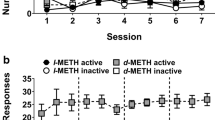Abstract
The development of tolerance to the hyperactivating effects of methylamphetamine was studied in the laboratory rat. The results of Experiment I indicated that tolerance did develop. In Experiment II these indications were confirmed and the time course of tolerance was plotted. It appeared that the development of tolerance could be divided into two phases: an initial period of about one week during which activity increased, possibly due to accumulation of the drug or a metabolite, and a later period lasting about six weeks during which activity gradually fell to the first day of drug administration.
Similar content being viewed by others
References
Angrist, B., Gershon, S.: Possible dose-response relationships in psychosis. In: Drug abuse-proceedings of the international conference, C. J. D. Zarafonetis, Eds., pp. 263–269. London: Lee and Febiger 1972
Anton, A. H., Greer, M.: Dextroamphetamine, catecholamines and behavior. Arch. Neurol. (Chic.) 21, 248–252 (1969)
Bell, D. S.: Addiction to stimulants. Med. J. Aust. I, 41–45 (1967)
Bell, D. S.: Double-blind trial of anorectic agents. Med. J. Aust. I, 599–600 (1969)
Brodie, B. B., Cho, A. K., Gressa, G. L.: Possible role of p-hydroxynorephedrine in the depletion of norepinephrine induced by d-amphetamine and in tolerance to this drug. In: Amphetamines and related compounds, pp. 217–230. Raven Press 1970
Cavanagh, J. H., Griffith, J. D., Oates, J. A.: The effect of acute and chronic amphetamine administration on the adrenergic neuron in man. In: Amphetamines and related compounds, E. Costa and S. Garratini, Eds. pp. 551–556. New York: Raven Press 1970
Ehrich, W. E., Kumbhaar, E. B.: The effects of large doses of Benzedrine sulphate on the albino rat: functional and tissue changes. Ann. intern. Med. 10, 1874–1888 (1937)
Ellinwood, E. H., Escalante, O.: Behavior and histopathological findings during chronic methedrine intoxication. Biol. Psychiat. 2, 27–39 (1970)
Hays, W. L.: Statistics for Psychologists. New York: Holt, Rinehart, and Winston 1963
Holm, T., Huus, I., Kopf, R., Neilsen, I. M., Peterson, P. V.: Pharmacology of a series of nuclear substituted phenyltertiary-butylamines with particular reference to anorexigenic and central stimulating properties. Acta pharmacol. (KM.) 17, 121–136 (1960)
Jellinek, E. M.: The disease concept of alcoholism. New Haven: Hillhouse Press 1960
Kirkby,R. J., Bell, D. S., Preston, A. C.: A technique for the measurement of drug induced activity in small animals. Proceedings of the 29th International Congress on Alcoholism and Drug Dependence: Sydney, Abstract (1970)
Lemberger, L., Witt, E. D., Davis, J. M., Kopin, I. J.: The effects of haloperidol and chlorpromazine on amphetamine metabolism and amphetamine stereotype behavior in the rat. J. Pharmacol. exp. Ther. 174, 428–433 (1970)
Lewander, T.: Urinary excretion and tissue levels of catecholamines during chronic amphetamine intoxication. Psychopharmacologia (Berl.) 13, 394–407 (1968)
Lewander, T.: A mechanism for the development of tolerance to amphetamine in rats. Psychopharmacologia (Berl.) 21, 17–31 (1971)
Randrup, A., Munkvad, I., Udsen, P.: Adrenergic mechanism and amphetamine induced abnormal behavior. Acta pharmacol. (Kbh.) 20, 245–257 (1963)
Rosenberg, D. E., Wolbach, A. B., Jr., Miner, E. J., Isbell, H.: Observations on direct and cross-tolerance with LSD and d-amphetamine in man. Psychopharmacologia (Berl.) 5, 1–15 (1963)
Sethy, V. H., Naik, P. Y., Sheth, U. K.: Effects of d-amphetamine sulphate in combination with CNS depressants on spontaneous motor activity of mice. Psychopharmacologia (Berl.) 18, 19–25 (1970)
Tainter, M. L.: Effects of certain analeptic drugs on spontaneous running activity in the white rat. J. comp. Psychol. 36, 143–155 (1943)
Tormey, J., Lasagna, L.: Relation of thyroid function to acute and chronic effects of amphetamine in the rat. J. Pharmacol. exp. Ther. 128, 201 (1960)
Uehling, B. S.: Effects of chronic d-amphetamine sulphate administration during development in rats. Int. J. Neuropharmacol. 8, 43–48 (1969)
Author information
Authors and Affiliations
Additional information
Supported by research funds from the New South Wales Department of Health. We are grateful for the assistance of Mr. Swist-Swirski in the running of these experiments.
Rights and permissions
About this article
Cite this article
Bell, D.S., Kirkby, R.J. & Preston, A.C. Tolerance to the hyperactivating effects of methylamphetamine. Psychopharmacologia 36, 41–47 (1974). https://doi.org/10.1007/BF00441380
Received:
Revised:
Issue Date:
DOI: https://doi.org/10.1007/BF00441380




